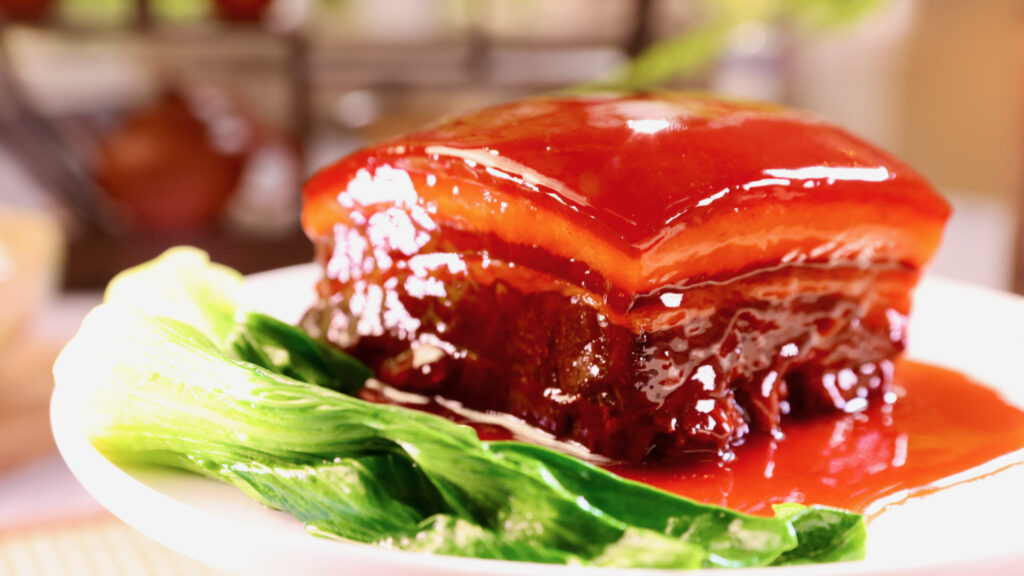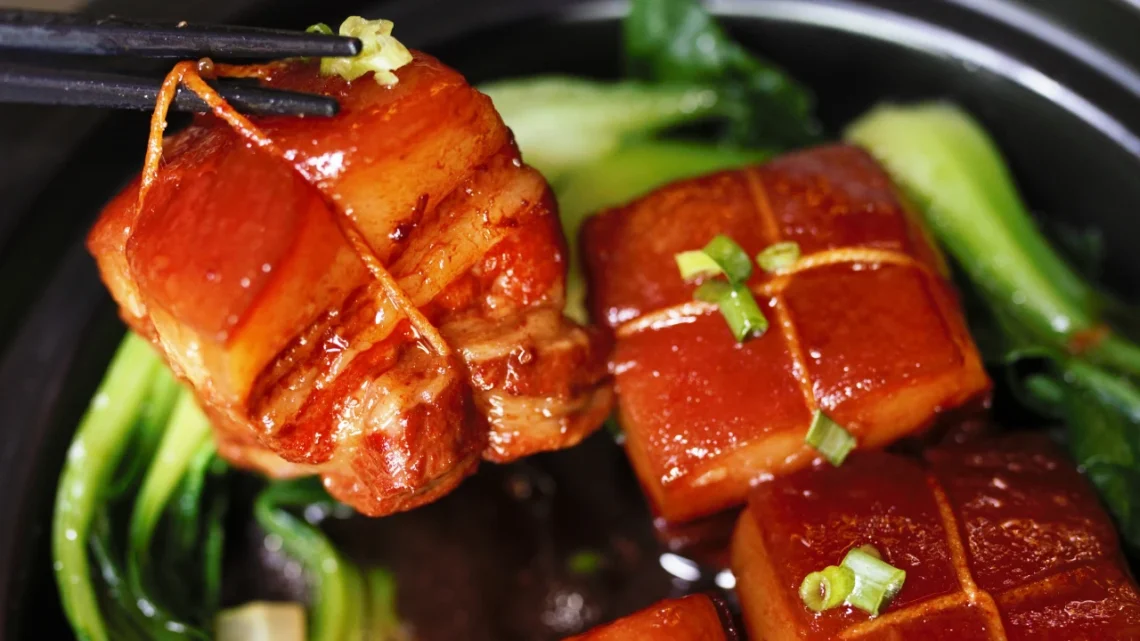Introduction to Dongpo Rou
Dongpo Rou is more than just a delicious braised pork belly dish—it’s a culinary emblem of Chinese heritage, history, and artistry. Named after the famous Song Dynasty poet and gastronome Su Dongpo, Dongpo Rou stands out for its melt-in-your-mouth texture, deep soy-infused flavor, and iconic red-brown glaze. You’ll often find it gracing banquet tables, family reunions, and festive gatherings in China, especially in Zhejiang Province and Hangzhou city.
But don’t mistake Dongpo Rou for just another pork dish. Its preparation is a slow, methodical process that transforms simple ingredients—pork belly, soy sauce, sugar, and Shaoxing wine—into something truly luxurious. The taste is tender and rich without being greasy, and it leaves behind a warm, lingering umami that’s hard to forget.
What makes Dongpo Rou especially fascinating is the story behind it. From its legendary origin to the careful techniques involved in its making, this dish encapsulates centuries of Chinese culinary tradition. In this article, we’ll break down everything about Dongpo Rou—from its history and cultural relevance to how it’s made and enjoyed today.
The History Behind Dongpo Rou: A Dish Born from Poetry and Passion
Dongpo Rou isn’t just named after Su Dongpo—it’s inseparable from his story. Su Dongpo (also known as Su Shi) was a revered poet, statesman, calligrapher, and gastronomist during the Song Dynasty (960–1279). He was known for his love of good food and wine as much as his literary genius. Legend has it that he created this dish himself—or at least inspired it.
According to popular folklore, when Su Dongpo was exiled to Hangzhou, he involved himself in the construction of a dike across the West Lake. To reward the workers, he sent them pork cooked in his favorite way: slowly braised with wine and soy sauce. The story goes that the pork was so delicious and well-received that the dish came to bear his name.
Another version tells of Su Dongpo accidentally creating the dish while attempting to multitask. He was braising pork while playing a game of chess and forgot about the pot on the stove. When he returned, the pork had become incredibly tender and aromatic—and a culinary masterpiece was born.
Regardless of which tale you believe, what’s clear is that Su Dongpo’s influence and the resulting recipe left a lasting mark on Chinese cuisine. His poetic sensibility and appreciation for good living are reflected in every bite of Dongpo Rou. It’s one of those rare dishes where the story is as rich as the flavor.

The Ingredients and Techniques: Simplicity Meets Mastery
On the surface, the ingredients for Dongpo Rou seem humble and minimal: pork belly, soy sauce, Shaoxing wine, sugar (usually rock sugar), ginger, and scallions. Yet, the magic lies in the technique—and patience.
Pork Belly: This cut is the foundation. It’s crucial to choose a thick, evenly layered piece with balanced fat and lean meat. The fat melts into the dish during cooking, creating that signature unctuous texture.
Braising Method: What sets Dongpo Rou apart is the two-step cooking process. First, the pork is blanched to remove impurities and then cut into large cubes—often tied with kitchen twine to hold their shape. Then comes the slow braise. The pork is gently simmered in a mix of soy sauce, Shaoxing wine, and sugar for hours, often over low heat or steamed in a clay pot.
Shaoxing Wine: This aged Chinese rice wine is vital. It infuses the dish with complexity and subtle sweetness that balances the richness of the pork.
Rock Sugar: Unlike regular white sugar, rock sugar melts slowly and evenly, creating a glossy, caramelized coating that gives Dongpo Rou its beautiful hue.
No Garlic or Chilies: Unlike other braised Chinese dishes, Dongpo Rou stays true to its roots by avoiding overpowering flavors. The beauty lies in the harmony of its base ingredients.
It’s a slow-cooked marvel that rewards patience. The pork becomes so tender you can break it apart with chopsticks, and the flavor is both deep and delicate. It’s this balance of technique, time, and taste that elevates Dongpo Rou to an art form.
Cultural Significance: More Than Just a Meal
Dongpo Rou holds a special place in Chinese culinary culture. It’s not a dish you throw together on a weekday night—it’s a ceremonial experience. In many households, preparing Dongpo Rou is reserved for holidays, family reunions, weddings, or other important celebrations.
In Hangzhou, where the dish is especially revered, Dongpo Rou is often seen as a local treasure. It’s regularly featured in formal banquets and is almost a rite of passage for visiting tourists eager to taste authentic regional cuisine. Some high-end restaurants even present it with flair—served in individual clay pots or wrapped in lotus leaves for added aroma and presentation.
Beyond taste, Dongpo Rou embodies core values in Chinese tradition: harmony, respect for elders, and appreciation for time and effort. The long cooking time is symbolic of patience and dedication, and its richness makes it suitable for communal dining—a key aspect of Chinese culinary culture.
There’s also a strong nostalgic element. For many Chinese people, Dongpo Rou brings back memories of home, grandparents, and special occasions. It’s the kind of dish that connects generations and tells stories in silence.
Variations and Regional Twist
While the classic Dongpo Rou remains largely the same, regional adaptations do exist. The most traditional version hails from Hangzhou, where it’s steamed rather than boiled, allowing for gentler heat and a more even texture. But you’ll also find slight variations depending on where you go in China.
Sichuan Version: In Sichuan, you might find Dongpo Rou with a slight kick from fermented bean paste or a touch of spice. It still respects the original base but adds a regional twist that caters to the local palate.
Shanghai Style: Shanghai’s version may lean a little sweeter, using more sugar and sometimes dark soy sauce to deepen the color and flavor. The pork may also be smaller in portion and more decorative in presentation.
Modern Takes: Contemporary chefs have also begun to experiment with Dongpo Rou. Some infuse it with tea flavors, while others serve it alongside fusion elements like mashed potatoes or risotto to appeal to international audiences. Though purists may frown upon these changes, they demonstrate the dish’s adaptability and enduring appeal.
Regardless of the version, the essence of Dongpo Rou remains unchanged: a deep respect for ingredients, technique, and the story behind it all.
How to Enjoy Dongpo Rou: The Perfect Pairings
Dongpo Rou is rich, so it’s best paired with simple, neutral sides that complement its depth without competing with it.
Steamed White Rice: The most traditional and arguably best pairing. The soft, slightly sticky rice absorbs the rich sauce and balances the pork’s richness perfectly.
Mantou (Steamed Buns): Another great option. These fluffy buns can be used to soak up the sauce or sandwich a piece of the pork for a more handheld experience.
Blanched Greens: Light vegetables like bok choy, spinach, or Chinese broccoli help cut through the dish’s fattiness and add a refreshing contrast.
Pickled Vegetables: Pickles add acidity and crunch, cleansing your palate between bites and keeping things interesting.
Some people also enjoy Dongpo Rou with a glass of Shaoxing wine or green tea, which enhances the flavors without overpowering them. It’s a dish meant to be savored slowly—bite by bite, sip by sip.
How to Make Dongpo Rou at Home
If you’re feeling inspired to make Dongpo Rou in your own kitchen, you’re in for a culinary adventure. Here’s a simplified version of the traditional recipe:
Ingredients:
- 1.5 lbs pork belly (skin-on)
- 1/2 cup Shaoxing wine
- 1/4 cup light soy sauce
- 2 tbsp dark soy sauce
- 1/4 cup rock sugar (or substitute with brown sugar)
- 5 slices ginger
- 3 scallions
- Water as needed
Instructions:
- Blanch the pork: Cut pork into 2-inch cubes. Blanch in boiling water for 5 minutes to remove impurities. Drain and pat dry.
- Tie the cubes: Optionally, tie each cube with kitchen twine to maintain their shape during braising.
- Arrange and braise: In a clay pot or heavy Dutch oven, lay scallions and ginger on the bottom. Place pork cubes on top, skin side down. Add Shaoxing wine, soy sauces, and sugar. Add enough water to almost cover the pork.
- Simmer or steam: Bring to a boil, then reduce to a very low simmer. Cover and cook for 2–3 hours, flipping occasionally. Some traditional methods involve steaming the pot in a larger vessel for gentler heat.
- Serve: Once the pork is deeply colored and tender, carefully remove and serve with rice or steamed buns.
The secret is low and slow—don’t rush it. You’ll be rewarded with a luxurious dish that feels both comforting and extravagant.
Conclusion:
Dongpo Rou is more than food—it’s a story, a tradition, and an experience. It represents the essence of Chinese cooking: using simple ingredients, respecting the process, and creating something unforgettable. Whether you’re enjoying it at a high-end Hangzhou restaurant or trying your hand at it in your own kitchen, Dongpo Rou delivers both flavor and history in every bite.
It’s not just about pork; it’s about poetry, patience, and pride. And once you’ve tried it, chances are you’ll find yourself returning to it again and again—not just for the taste, but for the feeling it evokes. It’s a classic for a reason.
So next time you’re exploring Chinese cuisine, don’t skip over Dongpo Rou. It might look like just a block of braised pork—but it’s so much more.





